Caryn’s Thoughts
 Many people know about the Christmas truce of 1914, when in World War I, thousands of British, French, and German troops, exhausted from fighting took the night of Christmas Eve to stop fighting, leave their trenches, and meet the enemy forces in what was known as “No Man’s Land” to exchange gifts, food, and stories. For the soldiers, it was a moral boost, but the Generals disagreed, and determined to prevent further fraternization in the future, saw to it that such activities would be severely punished, thereby ending future Christmas truces for the rest of that war, or the following war. I suppose the Christmas “truce” would have been better called a “cease fire” since they weren’t supposed to fraternize.
Many people know about the Christmas truce of 1914, when in World War I, thousands of British, French, and German troops, exhausted from fighting took the night of Christmas Eve to stop fighting, leave their trenches, and meet the enemy forces in what was known as “No Man’s Land” to exchange gifts, food, and stories. For the soldiers, it was a moral boost, but the Generals disagreed, and determined to prevent further fraternization in the future, saw to it that such activities would be severely punished, thereby ending future Christmas truces for the rest of that war, or the following war. I suppose the Christmas “truce” would have been better called a “cease fire” since they weren’t supposed to fraternize.
In World War II, of course, there was no such truce called, and the fighting continued without taking notice of the holiday. Nevertheless, in 1944, during the Battle of the Bulge, the generals lost just a little bit of their control over the people, when in defiance of the orders, a small group of unlikely guests made their way to a little cabin in the Hurtgen Forest, for a little Christmas Truce of their own. They could have been in so much trouble had they been found out by superior officers, but at the time it just didn’t seem to matter, or maybe it was their host, one Elisabeth Vincken, who along with her 12 year old son stood up to the soldiers, and held off the battle for a few hours. After their home in Aachen was completely destroyed, Elisabeth and her son, Fritz were sent to their cabin, about four miles from Monschau in the Hurtgen Forest near the Belgian border. Her husband visited them as often as he could, but he needed to work. On that Christmas, Elisabeth and Fritz, had been hoping her husband would arrive to spend Christmas with them, but now they knew it was too late. Their Christmas meal would now have to wait for his arrival. Elisabeth and Fritz were alone in the cabin.
Then, the miracle began. Lost in the snow-covered Ardennes Forest, three American soldiers…one badly wounded, wandered around, trying to find the American lines. These poor men had been walking for three days while the sounds of battle echoed in the hills and valleys all around them. They had now idea who was shooting, so they dared not enter the area. Then, on Christmas Eve, they came upon a small cabin in the woods. They cautiously knocked at the door, hoping that they didn’t get shot. Elisabeth blew out the candles and opened the door to find two enemy American soldiers standing at the door and a third lying in the snow behind them. These men might have been soldiers, but were hardly older than boys. The men were armed and 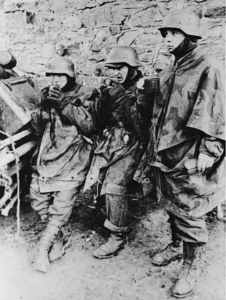 could have simply pushed their way in, but they hadn’t, so she invited them inside and they carried their wounded comrade into the warm cabin. Elisabeth didn’t speak English and they didn’t speak German, but they managed to communicate in broken French. After she heard their story and saw the wounded soldier, Elisabeth gave up the idea of saving the Christmas meal for when her husband could get there. She started preparing a meal for the men. She sent Fritz to get six potatoes and Hermann the rooster…his stay of execution while they waited for her husband was now rescinded. Hermann had been named after Hermann Goering, the Nazi leader, who Elisabeth didn’t care much for. Maybe killing the rooster would make her feel better.
could have simply pushed their way in, but they hadn’t, so she invited them inside and they carried their wounded comrade into the warm cabin. Elisabeth didn’t speak English and they didn’t speak German, but they managed to communicate in broken French. After she heard their story and saw the wounded soldier, Elisabeth gave up the idea of saving the Christmas meal for when her husband could get there. She started preparing a meal for the men. She sent Fritz to get six potatoes and Hermann the rooster…his stay of execution while they waited for her husband was now rescinded. Hermann had been named after Hermann Goering, the Nazi leader, who Elisabeth didn’t care much for. Maybe killing the rooster would make her feel better.
While Hermann roasted and dinner was being prepared, there was another knock on the door. Fritz went to open it, thinking there might be more lost Americans, but instead there were four armed German soldiers. Seeing the German soldiers, and realizing that she could be killed for harboring the enemy, Elisabeth turned white as a ghost. She quickly pushed past Fritz and stepped outside. There was a corporal and three very young soldiers, who wished her a Merry Christmas, but they were lost and hungry. Knowing she had no choice, Elisabeth told them they were welcome to come into the warmth and eat until the food was all gone, but that there were others inside who they would not consider friends. The reaction she expected came when the corporal asked sharply if there were Americans inside and she said there were three who were lost and cold like they were and one was wounded. The corporal stared hard at her. She had to do something, so she said, “Es ist Heiligabend und hier wird nicht geschossen.” In German, that means, “It is the Holy Night and there will be no shooting here.” She insisted they leave their weapons outside. The men couldn’t believe that this woman was standing up to them in such a way. Nevertheless, the men decided to comply and Elisabeth went inside, demanding the same of the Americans. She took their weapons and put them outside next to the Germans’.
Understandably, the fear and tension in the cabin was high as the Germans and Americans eyed each other warily. Nevertheless, the warmth and smell of roast Hermann and potatoes soon eased the tension, and while the men were still wary, the meal was somewhat cordial. The Germans produced a bottle of wine and a loaf of bread. While Elisabeth tended to the cooking, one of the German soldiers, an ex-medical student, examined the wounded American. In English, he explained that the cold had prevented infection, but the man had lost a lot of blood. He needed food and rest. By the time the meal was ready, the atmosphere in the cabin was more relaxed. Two of the Germans were only sixteen, and the corporal was only 23. As Elisabeth said grace, Fritz 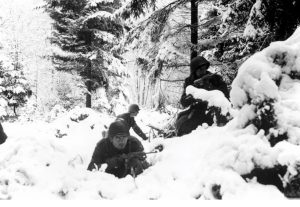 noticed tears in the exhausted soldiers’ eyes…both German and American. The moment had somehow touched them all. The unauthorized and very much unplanned “truce” lasted through the rest of that night, and into the morning. The German corporal looked at the map the Americans had, and pointed out the best way for the men to get back to their lines. He also gave them a compass. The Americans asked if they should instead go to Monschau, but the corporal shook his head and said that the Germans had taken Monschau. Elisabeth returned all their weapons and the enemies shook hands and left the cabin, in opposite directions. Soon they were all out of sight, and the truce was over.
noticed tears in the exhausted soldiers’ eyes…both German and American. The moment had somehow touched them all. The unauthorized and very much unplanned “truce” lasted through the rest of that night, and into the morning. The German corporal looked at the map the Americans had, and pointed out the best way for the men to get back to their lines. He also gave them a compass. The Americans asked if they should instead go to Monschau, but the corporal shook his head and said that the Germans had taken Monschau. Elisabeth returned all their weapons and the enemies shook hands and left the cabin, in opposite directions. Soon they were all out of sight, and the truce was over.

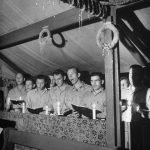 Most people have heard the song, “I’ll Be Home For Christmas” which was written by lyricist, Kim Gannon and composer, Walter Kent. Most of us also know that the song was recorded by Bing Crosby, putting it in the older, classic category. We also knew that if was probably written, and in reality was written to honor soldiers overseas, who really wished they could be home for Christmas. I wasn’t sure what year it was written, but have since looked it up to find, exactly as I expected, that it was in 1943 during World War II. Our boys were off fighting, and Christmas was going to be very different that year, for the families, but mostly for the soldiers, many of whom would be away for the first time in their life.
Most people have heard the song, “I’ll Be Home For Christmas” which was written by lyricist, Kim Gannon and composer, Walter Kent. Most of us also know that the song was recorded by Bing Crosby, putting it in the older, classic category. We also knew that if was probably written, and in reality was written to honor soldiers overseas, who really wished they could be home for Christmas. I wasn’t sure what year it was written, but have since looked it up to find, exactly as I expected, that it was in 1943 during World War II. Our boys were off fighting, and Christmas was going to be very different that year, for the families, but mostly for the soldiers, many of whom would be away for the first time in their life.
These days are really no different, except that quite possibly the old song, “I’ll Be Home For Christmas” has taken on additional meanings. For those who have soldiers serving all around the world, the old classic meaning brings a renewed feeling of the old meaning of wishing their soldiers were home. For many others of us, who have loved ones who live far away, it brings memories of Christmas’ past, when our children were little and everyone was with us, gathered around the tree and dinner table. Others are fighting off the Covid-19 virus, and are quarantined this Christmas. And still others are facing a very different kind of sadness and loneliness this Christmas. Some have lost loved ones to the Covid-19 virus. For others there are other causes for their loved one’s passing, but it doesn’t matter what the cause…the passing of a loved one is the worst loss that can ever be felt…any time of year.
The song, “I’ll Be Home For Christmas” is the epitome of of our longing spirit. Sometimes we feel like we need a good cry, and yes, we probably do, but that will never really ease the pain…especially the pain of loss. Time and prayer are the only was to move forward. We will never forget our loved ones, but we know that they are safe 
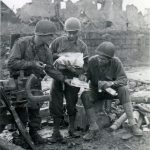 in Heaven, and we will see them again soon. Our soldiers will come home, our children living far away are only a plane ride away, our loved ones who are ill will recover, and there will be other Christmases. Can we ever get this Christmas back…no, but most of us can celebrate when loved ones get home or well, and still others can talk on the phone, Facetime, or Skype, so the miles seem to melt away. Whatever the reason for our fractured Christmas, this year and years in the past, we can all relate to the meaning behind the song, “I’ll Be Home For Christmas” and when we all get to Heaven, we will truly see that dream come true.
in Heaven, and we will see them again soon. Our soldiers will come home, our children living far away are only a plane ride away, our loved ones who are ill will recover, and there will be other Christmases. Can we ever get this Christmas back…no, but most of us can celebrate when loved ones get home or well, and still others can talk on the phone, Facetime, or Skype, so the miles seem to melt away. Whatever the reason for our fractured Christmas, this year and years in the past, we can all relate to the meaning behind the song, “I’ll Be Home For Christmas” and when we all get to Heaven, we will truly see that dream come true.
 With the death of the Holy Roman Emperor Lothair II in 1137, Henry the Proud was the Welf heir of the patrimony of his deceased father-in-law, and possessor of the crown jewels. I always find that strange. Because Henry the Proud had married the Emperor’s daughter, Gertrude, it was he and not the Emperor’s daughter who became the heir and who possessed the crown jewels. Her name is often not mentioned at all. Still, as most of us know, the wife should never be discounted as being insignificant. She will prove you wrong every time.
With the death of the Holy Roman Emperor Lothair II in 1137, Henry the Proud was the Welf heir of the patrimony of his deceased father-in-law, and possessor of the crown jewels. I always find that strange. Because Henry the Proud had married the Emperor’s daughter, Gertrude, it was he and not the Emperor’s daughter who became the heir and who possessed the crown jewels. Her name is often not mentioned at all. Still, as most of us know, the wife should never be discounted as being insignificant. She will prove you wrong every time.
The Siege of Weinsberg took place in Weinsberg, which is in the modern state of Baden-Württemberg, Germany. At that time, Weinsberg was part of the Holy Roman Empire. As often happens, nations and kingdoms often disagree on matters, and wars ensue. The Siege of Weinsberg was a decisive battle between two dynasties…the Welfs and the Hohenstaufen. For the first time, the Welfs changed their war cry from “Kyrie Eleison” to their party cries. The Hohenstaufen used the ‘Strike for Gibbelins’ war cry. Unlike wars these day, apparently, the war cry was very important. I suppose that it was similar to “Charge!!” It was a necessary command to let everyone know that the moment of truth had arrived. Part of the problem might have been the same one that I found odd…Henry the Proud was the son-in-law, and not the son…meaning that had the daughter not married, someone else would have been made the heir.
Henry was a loyal supporter in the warfare between his father-in-law King Lothair and the Hohenstaufen brothers, Duke Frederick II (who was Henry’s brother-in-law, having been married with his sister Judith) and Conrad, then duke of Franconia and anti-king of Germany. While engaged in this struggle, Henry was also occupied in suppressing an uprising in Bavaria, led by Count Frederick of Bogen, during which both duke and  count sought to establish their own candidates as bishop of Regensburg. After a war of devastation, Count Frederick submitted in 1133, and two years later the Hohenstaufen brothers made their peace with Emperor Lothair. Because of his loyalty, Henry stood as a candidate for emperor when his father-in-law passed. However, the local princes were very much against him, so they elected Conrad III, a Hohenstaufen, in Frankfurt on February 2, 1138.
count sought to establish their own candidates as bishop of Regensburg. After a war of devastation, Count Frederick submitted in 1133, and two years later the Hohenstaufen brothers made their peace with Emperor Lothair. Because of his loyalty, Henry stood as a candidate for emperor when his father-in-law passed. However, the local princes were very much against him, so they elected Conrad III, a Hohenstaufen, in Frankfurt on February 2, 1138.
Conrad III immediately began the process of governing, no matter how improper or illegal his reign was. When Conrad III gave the Duchy of Saxony to Count Albert the Bear, the Saxons rose in defense of their young prince, and Count Welf of Altorf, the brother of Henry the Proud, began the war. The reign of Conrad was illegal. He was not the emperor Lothair II had planned to pass his mantle to. The crowning of this illegal emperor outraged the Welfs, and the immediately retaliated. Conrad III had planned to destroy Weinsberg and imprison its soldiers. Still, he was not completely heartless, and in a kind hearted moment, he suspended the final assault after a surrender was negotiated. Conrad III could not kill the women and children. He told the women of the city that they were to be granted the right to leave with whatever they could carry on their shoulders. He though he was going to let them have enough to set themselves up elsewhere, but he underestimated the women.
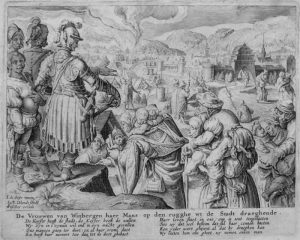 I don’t know if the women planned what happened next…they must have, because with one accord, they left their possessions, lifting their husbands and children on their backs, they headed out of town. Of course, it was within the power of the emperor to then kill the women too, but he was honorable. When the emperor, saw what was happening, he actually laughed and accepted the women’s clever trick. He decreed that a king should always stand by his word…and he let them go with their families intact. This story became known as the “Loyal Wives of Weinsberg” (Treue Weiber von Weinsberg). The castle ruins are today known as Weibertreu (“wifely loyalty”) in commemoration of the event. I cant say if the story is true, or a fable, but either way, it speaks to the true love a wife has for her husband.
I don’t know if the women planned what happened next…they must have, because with one accord, they left their possessions, lifting their husbands and children on their backs, they headed out of town. Of course, it was within the power of the emperor to then kill the women too, but he was honorable. When the emperor, saw what was happening, he actually laughed and accepted the women’s clever trick. He decreed that a king should always stand by his word…and he let them go with their families intact. This story became known as the “Loyal Wives of Weinsberg” (Treue Weiber von Weinsberg). The castle ruins are today known as Weibertreu (“wifely loyalty”) in commemoration of the event. I cant say if the story is true, or a fable, but either way, it speaks to the true love a wife has for her husband.

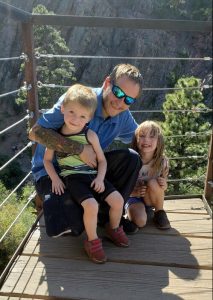 There are some kids that you can take one look at, and you know without a doubt that they are feisty and full of spunk. My great grand-niece, Izabella Harman is one of those kids. Belle, has sparkling eyes to match her sparkling personality, and she has the wit and smile to match. She loves life and loves her family, especially her older sister, Alice and younger brother, Jaxx. Nevertheless, she is very independent, and her mom Melanie Harman tells me that Belle has this “random rudeness,” just like her dad, Jake Harman, but somehow, her sarcasm doesn’t bring the same reaction as it does with her dad. In fact, it’s all her parents can do not to laugh at their little girl trying to show off her rude sarcasm, and all she can pull off is funny sarcasm.
There are some kids that you can take one look at, and you know without a doubt that they are feisty and full of spunk. My great grand-niece, Izabella Harman is one of those kids. Belle, has sparkling eyes to match her sparkling personality, and she has the wit and smile to match. She loves life and loves her family, especially her older sister, Alice and younger brother, Jaxx. Nevertheless, she is very independent, and her mom Melanie Harman tells me that Belle has this “random rudeness,” just like her dad, Jake Harman, but somehow, her sarcasm doesn’t bring the same reaction as it does with her dad. In fact, it’s all her parents can do not to laugh at their little girl trying to show off her rude sarcasm, and all she can pull off is funny sarcasm.
Belle is a girly girl. She loves her makeup and lip gloss, her shoes and her clothes! The dunny thing is that as much as Belle loves her makeup, she really won’t need much as she gets older. Her eyes are beautiful, and will likely need little help, but like most girls, she will probably wear it anyway…and that’s ok too. She’s definitely a princess at heart. Of course, in my opinion, girly girls are great fun, because they make so many cute and frilly outfits for girls, and if the girl doesn’t like that stuff, it’s a bummer. These days, they even have tutu skirts, which we never would have put our girls in, in my day, but maybe we missed it, because they look so cute. Pair that with a pair of leggings and a cute top, and you have a girly girl’s dream outfit. These outfits are Belle’s idea of cute, and I agree.
Belle is such a cool little kid. She and her older sister, Alice keep their younger brother, Jaxx totally entertained. All I can say is, that it’s a good thing her parents are so young at heart, because they rarely mind the loud play 

 and giggles that are common when you have three kids in the house. The reality is, your kids are only this little once, you might as well enjoy it. Sometimes Jake and Melanie post some videos of the kids at play, and it is very cool to hear their giggles and laughter. They wrestle around, make faces, and then they laugh about just how funny they are. And they really are. Today is Belle’s 5th birthday. Happy birthday Belle!! Keep being you, because we love it. Have a great day!! We love you!!
and giggles that are common when you have three kids in the house. The reality is, your kids are only this little once, you might as well enjoy it. Sometimes Jake and Melanie post some videos of the kids at play, and it is very cool to hear their giggles and laughter. They wrestle around, make faces, and then they laugh about just how funny they are. And they really are. Today is Belle’s 5th birthday. Happy birthday Belle!! Keep being you, because we love it. Have a great day!! We love you!!

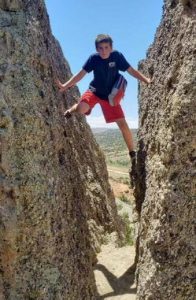 My nephew, Isaac Spethman is a very athletic kid. One of his favorite things to do is climb. I suppose you could call him the Houdini of climbing. Houdini was an illusionist, but he was also a stunt performer. I don’t know if Isaac likes illusionist tricks, but he definitely likes stunts. He also love to go with his mom when they are “adventuring.” He loves to forge. I think this kid might be half mountain man. Isaac doesn’t just look around for trinkets he can sell, he melts down pop cans and makes shapes out of them. He has also made knives out of spikes and rebar. I’m sure that one of his favorite shows is probably “Forged In Fire,” which is all about knife making. I have to admit that I like it too. The process is very interesting.
My nephew, Isaac Spethman is a very athletic kid. One of his favorite things to do is climb. I suppose you could call him the Houdini of climbing. Houdini was an illusionist, but he was also a stunt performer. I don’t know if Isaac likes illusionist tricks, but he definitely likes stunts. He also love to go with his mom when they are “adventuring.” He loves to forge. I think this kid might be half mountain man. Isaac doesn’t just look around for trinkets he can sell, he melts down pop cans and makes shapes out of them. He has also made knives out of spikes and rebar. I’m sure that one of his favorite shows is probably “Forged In Fire,” which is all about knife making. I have to admit that I like it too. The process is very interesting.
Isaac is a hunter now that he has passed his hunter safety class. He and his siblings have grown up around guns, and their parents have taught them, not only safety, but the value of life human or otherwise. They would never kill anything just to kill. They have too much respect for life to ever consider that to be ok. Isaac’s love of hunting and guns has made knives interesting to him as well, hence the love of forge a knife. Isaac 
 enjoys other sports too, like wrestling and football. He is very good at both. He is not a husky kid, but rather is wiry, and that makes him a good wrestler. He is also a capable runner, which makes him a good football player, but most importantly, he is full of energy. He doesn’t like to just sit around. In fact, slow down…is not a phrase in his vocabulary.
enjoys other sports too, like wrestling and football. He is very good at both. He is not a husky kid, but rather is wiry, and that makes him a good wrestler. He is also a capable runner, which makes him a good football player, but most importantly, he is full of energy. He doesn’t like to just sit around. In fact, slow down…is not a phrase in his vocabulary.
Isaac is the youngest of his sister, Aleesia’s three older brothers. That makes him a couple of things. Being the youngest of the three brothers, he has had to learn to defend himself. His brothers, Xander and Zack are good boys who love their brothers and sister, but there is still that “I’m the boss of you” aspect of their relationship. That makes him both tough, and sometimes, put upon. Being the youngest of the boys, the only one he can be the “boss of” is his little sister, Aleesia. With that, it naturally follows that he is the most ornery to Aleesia, but make no mistake about it, he also watches her like a hawk. I’m sure that Aleesia has mixed feeling about all that, depending on what she needs him to be at the 

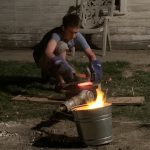 time. A brother who won’t let you out of his sight can be annoying, until someone decides to pick on you or you get in a jam. Then that brother is a very good thing to have around…as Aleesia well knows. Today is Isaac’s 14th birthday. I can’t believe he is 14. It seems like just yesterday that he was the baby. Happy birthday Isaac!! Have a great day!! We love you!!
time. A brother who won’t let you out of his sight can be annoying, until someone decides to pick on you or you get in a jam. Then that brother is a very good thing to have around…as Aleesia well knows. Today is Isaac’s 14th birthday. I can’t believe he is 14. It seems like just yesterday that he was the baby. Happy birthday Isaac!! Have a great day!! We love you!!
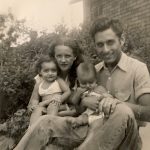
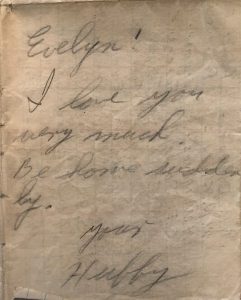 My uncle, George Hushman was “gone” on my aunt, Evelyn Byer from the moment he met her. You can’t blame him, because she was a beautiful woman. Once they were together, not much else mattered. They would have been as happy living in a shack in the slums, as they would have living in a palace. In reality, they lived in a beautiful, modest home, that they built themselves…or at least helped build. I’m sure that a contractor was involved too. I remember that house well. Uncle George would have given Aunt Evelyn the moon if he could have. Like many young couples, there were love notes. I happen to see on as I was helping to scan the family pictures. It was not long, but it was very sweet. Uncle George wrote, “Dear Evelyn, I love you very much. Be home suddenly. Love, Your Hubby.” It was a simple gesture, but the “suddenly” part is what caught my attention. It implied that he would really hurry home, and he couldn’t wait to see her. That was the kind of love they had.
My uncle, George Hushman was “gone” on my aunt, Evelyn Byer from the moment he met her. You can’t blame him, because she was a beautiful woman. Once they were together, not much else mattered. They would have been as happy living in a shack in the slums, as they would have living in a palace. In reality, they lived in a beautiful, modest home, that they built themselves…or at least helped build. I’m sure that a contractor was involved too. I remember that house well. Uncle George would have given Aunt Evelyn the moon if he could have. Like many young couples, there were love notes. I happen to see on as I was helping to scan the family pictures. It was not long, but it was very sweet. Uncle George wrote, “Dear Evelyn, I love you very much. Be home suddenly. Love, Your Hubby.” It was a simple gesture, but the “suddenly” part is what caught my attention. It implied that he would really hurry home, and he couldn’t wait to see her. That was the kind of love they had.
My sisters and I spent many fun filled days there hanging out with the Hushman kids, Susie, George, Shelley, Shannon, and Greg. Aunt Evelyn and our mom, Collene (Byer) Spencer, were very close, so naturally, the two families spent lots of time together. Aunt Evelyn and Uncle George were fun-loving people. They had so much in common with my parents, and they were as much friends as relatives. For many years they were on a bowling league together, went on date nights together, and spent lots of time at each others house. There is a lot to be said for good friends, and when that good friend is also family, there is a surety that the friendship will last a lifetime…and so it did.
As the years went by, the foursome grew older, and even though they still loved each other very much, they couldn’t get together as much as they used to. It was a disappointment for all of them. Before long they were 
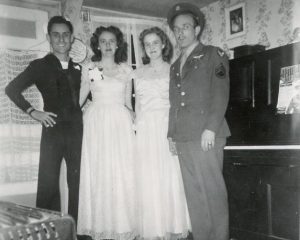 going home to Heaven…one by one. That is what made all of us the most sad. Uncle George was the last one to go home, and we were very sorry to see him go, because it was truly the end of an era. The foursome was gone now, and there would be no more of their dates, bowling, or their antics…which we all saw from time to time. It was really a sad time. Today would have been Uncle George’s 94th birthday. Happy birthday in Heaven, Uncle George. We love and miss you very much.
going home to Heaven…one by one. That is what made all of us the most sad. Uncle George was the last one to go home, and we were very sorry to see him go, because it was truly the end of an era. The foursome was gone now, and there would be no more of their dates, bowling, or their antics…which we all saw from time to time. It was really a sad time. Today would have been Uncle George’s 94th birthday. Happy birthday in Heaven, Uncle George. We love and miss you very much.

 My niece, Michelle Stevens is a very talented artist, but what I didn’t know, or didn’t realize, is that she also has a heart of gold. I always knew she was a sweetheart, but she is also a wonderful giver and teacher. Recently, I was working on a gift I wanted to give to my sisters, and I knew that if I wanted it to look as good as the picture I had in my head of what it would look like, I would need help. And I knew that Michelle was the one to ask. The gifts were to be a combination of an antique looking heart filled with trinkets, and some lettering, which was where I knew I would need help. Little did I know it wasn’t the only place I would need help.
My niece, Michelle Stevens is a very talented artist, but what I didn’t know, or didn’t realize, is that she also has a heart of gold. I always knew she was a sweetheart, but she is also a wonderful giver and teacher. Recently, I was working on a gift I wanted to give to my sisters, and I knew that if I wanted it to look as good as the picture I had in my head of what it would look like, I would need help. And I knew that Michelle was the one to ask. The gifts were to be a combination of an antique looking heart filled with trinkets, and some lettering, which was where I knew I would need help. Little did I know it wasn’t the only place I would need help.
Of course, with her big heart, Michelle agreed to do the lettering for me…even though in the end, I didn’t really give her the amount of time I should have. Then, as I was gluing the trinkets onto the canvas, I sent her a frantic text. Looking at my work, I thought, “This is awful!!” I was so disgusted that I sent Michelle a text saying, “Ugh!! I’m about as artistic as a box of rocks!! What does this need??” I wanted to cry. Somehow, Michelle saw something I couldn’t. She told me it looked good…and that the problem with homemade gifts is that part way through, you begin to doubt yourself…a time she calls the “ugly teenaged phase.” Well it was ugly alright. My clumsy fingers kept dropping the trinkets and there was shiny glue everywhere. It was a mess. Nevertheless, Michelle knew how to fix it. She also knew how to best phrase what I wanted to say on the project. When she was done, they were a gift I was proud to give to my sisters. I’m sure you’ll agree that in the end, and only because of Michelle’s expertise, they turned out beautifully.
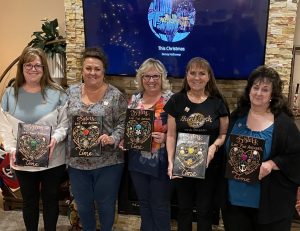

I am so proud of my niece and her wonderful artistic abilities. Of course, her own work is absolutely stunning, but with her teaching abilities, she can take even the most bumbling attempt at art, and make it look amazing. Her artistic ability makes her an excellent artist, and her heart of gold makes her an amazing person and teacher. That is a combination that is so special, and a gift few possess. Today is Michelle’s birthday. Happy birthday Michelle!! Have a great day!! We love you, and thank you sooooo much for your expert help!!
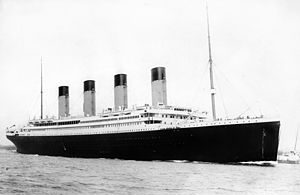 When a ship sinks, the first person to bring up an object from a wreck can claim legal ownership of the wreck under international maritime law. That gives that person the control of the wreck and control over salvage rights. Robert Ballard, one of the men who discovered the Titanic in 1985, had mixed feelings about disturbing the graves of those victims who are still there…a very noble man, if you ask me. Ballard’s partner, Jean-Lous Michel, agreed. They made the decision not to disturb the wreck, but rather to leave it in the pristine (for a wreck) condition that it was in. They didn’t bring up anything from the wreck.
When a ship sinks, the first person to bring up an object from a wreck can claim legal ownership of the wreck under international maritime law. That gives that person the control of the wreck and control over salvage rights. Robert Ballard, one of the men who discovered the Titanic in 1985, had mixed feelings about disturbing the graves of those victims who are still there…a very noble man, if you ask me. Ballard’s partner, Jean-Lous Michel, agreed. They made the decision not to disturb the wreck, but rather to leave it in the pristine (for a wreck) condition that it was in. They didn’t bring up anything from the wreck.
Unfortunately, their act of decency and kindness, left a legal door open, and that has been the greatest source of regret for the two men. Because they chose to bring nothing up from the wreck, they could not claim legal ownership of Titanic. Unfortunately, that left the ship vulnerable, because anyone and everyone now had a legal right for salvage the contents, and even parts of the ship…and they did. The artifacts and ship parts were free for the taking…and they were big business, especially after the movies came out, and interest grew. Soon, Titanic Ventures went in to claim salvage rights, and began bringing up artifacts to sell for exhibits and souvenirs. Since then, they have made a fortune on exhibits all over the world.
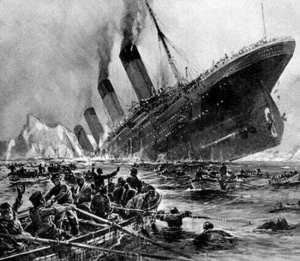
Following the find, and subsequent decision not to remove an artifact, anyone with the ability to explore the ocean floor that deep, went in and raided the ship. I’m sure that many of us have seen the Titanic exhibits, me included, and even purchased one of the artifacts, me included, but in my defense, I did not know the thoughts and wishes of Ballard and Michel, or the thoughts and feelings of the families of the deceased, at that time. I looked at the exhibit as a learning tool. I love learning, and I love history, and in fact, one of my own ancestors died on the Titanic, which I suppose gave me as much right to see the exhibit as anyone, but I’m still not sure it is right to make money off of the horrific way others lost their lives.
I remember as I went through the exhibit, walking through the recreation of the steerage rooms, with the eerie sounds of the water on the outside, thinking of the people who had been trapped there on that fateful night. I remember looking at the piece of the hull, thinking that I was standing almost close enough to reach out and touch part of a ship that had been so far under the ocean. I have seen both versions of the Titanic movies, but while looking at the exhibit, it was the original movie that came to my mind. Titanic wasn’t really a love story. 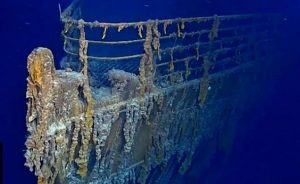 It was a loss story. It was a story of bravery, courage, and yes, love…the kind of love that made a wife refuse to leave her husband and parents to comfort their children, when all hope of survival was lost…holding in the tears of knowing that their children would never get to live their life to adulthood. When I think about all the lives that were lost on that fateful day, I can see how Ballard and Michel would want to leave the Titanic as it was, thereby preserving the graves of all those poor souls. While their idea was noble, it is sad that they didn’t bring at least one thing us so that their ownership and control could remain the gift they had planned to give the families.
It was a loss story. It was a story of bravery, courage, and yes, love…the kind of love that made a wife refuse to leave her husband and parents to comfort their children, when all hope of survival was lost…holding in the tears of knowing that their children would never get to live their life to adulthood. When I think about all the lives that were lost on that fateful day, I can see how Ballard and Michel would want to leave the Titanic as it was, thereby preserving the graves of all those poor souls. While their idea was noble, it is sad that they didn’t bring at least one thing us so that their ownership and control could remain the gift they had planned to give the families.
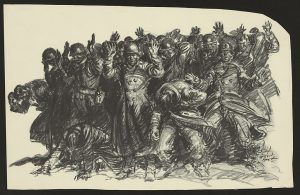 The many atrocities of the Nazi soldiers are well known, but somehow, every time I read about another one, I am very shocked again. I suppose that the prisoners of war were treated better than the Jews or the political prisoners, but I don’t think it was enough better to really take notice of. The Third Reich was an equal opportunity murder machine. Somehow they felt certain that they could get away with anything they wanted to do.
The many atrocities of the Nazi soldiers are well known, but somehow, every time I read about another one, I am very shocked again. I suppose that the prisoners of war were treated better than the Jews or the political prisoners, but I don’t think it was enough better to really take notice of. The Third Reich was an equal opportunity murder machine. Somehow they felt certain that they could get away with anything they wanted to do.
During the Battle of the Bulge, which was a major German offensive campaign on the Western Front during World War II. It took place from December 16, 1944 to January 25, 1945. The battle was launched through the densely forested Ardennes region of Wallonia in eastern Belgium, northeast France, and Luxembourg, towards the end of the war in Europe. The war was winding down, and the Germans knew they were losing. It was during this time that they began trying to get rid of the evidence.
The Malmedy massacre was the result of their attempt to hide what they were doing. I was a war crime committed by members of Kampfgruppe Peiper, which is a part of the SS Division Leibstandarte, a German Waffen-SS unit led by Joachim Peiper, at Baugnez crossroads near Malmedy, Belgium, on December 17, 1944. 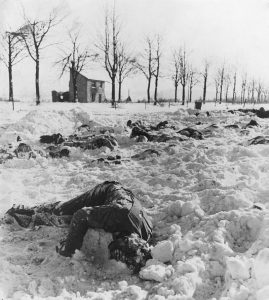 In all, 84 American prisoners of war were massacred by their German captors. The Germans assembled the prisoners in a field and mowed them down with machine guns. Afterward, they walked through the field and any of the prisoners who were still alive were killed by close-range shots to the head.
In all, 84 American prisoners of war were massacred by their German captors. The Germans assembled the prisoners in a field and mowed them down with machine guns. Afterward, they walked through the field and any of the prisoners who were still alive were killed by close-range shots to the head.
The term Malmedy massacre has also been generally associated with the series of massacres committed by the same unit on the same day and following days. These men were intent on getting rid of the evidence of their crimes. With these men living, they could tell the world how they had been treated. They felt that the if the men were dead, then Germany could get out of the war crimes. Nevertheless, they killed these men in vain, because the killings were the subject of the Malmedy massacre trial, which was part of the Dachau Trials of 1946.
 I am always amazed when a structure stands so long that no one can remember how it came to be. At the southern end of the Appalachian Mountains, there is a small range called the Cohutta Mountains. One mountain in that range is called Fort Mountain. It gets its name from the remnants of a stone formation located on the peak. It has been determined that the structure is ancient, and some sources have indicated that it was possibly built around 400-500 AD, while other sources will not commit to any age. I suppose that the very age of the structure would give good reason as to why it’s origins are unknown.
I am always amazed when a structure stands so long that no one can remember how it came to be. At the southern end of the Appalachian Mountains, there is a small range called the Cohutta Mountains. One mountain in that range is called Fort Mountain. It gets its name from the remnants of a stone formation located on the peak. It has been determined that the structure is ancient, and some sources have indicated that it was possibly built around 400-500 AD, while other sources will not commit to any age. I suppose that the very age of the structure would give good reason as to why it’s origins are unknown.
The zigzagging structure is about 885 feet long, and up to 12 feet thick. It stands up to 7 feet high, but many of the sections are only two to three feet high. The wall, which is scattered with 29 pits, cairns, small cylinders, stone rings, and ruins of a gateway, has stood in its place against all odds. It has stood the test of time, weather, gravity, and even people to continue to stand in its place, high on a mountain peak today.
There are several theories as to who might have built this wall. Some people who found the wall very early on called the structure a fort. They speculated that Hernando de Soto might have built it to defend against the Creek Indians around 1540. This theory was disproven when as early as 1917, when a historian pointed out that de Soto was in the area for less than two weeks. That wouldn’t have been enough time to build a structure that was going to stand the test of time.
There are two other legends floating around that said that the wall was built either by the “Moon-eyed” people according to Cherokee lore or is contributed to a Welsh prince who was said to have made his way to America in 1170. According to Cherokee legend, the “Moon-eyed” people lived in the lower Appalachia region before the 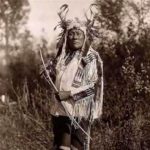 Cherokee came to the area during the late 1700s. The people were said to be called “moon-eyed” because they saw poorly during the day and could see very well at night. It is said that they were small in stature, possibly midgets or dwarfs. The men wore beards, and the people were light-eyed, with very pale white skin. One early historian suggested that they might have been albinos…possibly the ancestors of the Kuna people of Panama, who have a high incidence of albinism.
Cherokee came to the area during the late 1700s. The people were said to be called “moon-eyed” because they saw poorly during the day and could see very well at night. It is said that they were small in stature, possibly midgets or dwarfs. The men wore beards, and the people were light-eyed, with very pale white skin. One early historian suggested that they might have been albinos…possibly the ancestors of the Kuna people of Panama, who have a high incidence of albinism.
It is said that the Cherokee Indians drove them out of the region. Some say that these people built the ancient structures in the area. They thought the structure might have been a temple. The “moon-eyed” people were first mentioned in a 1797 book by Benjamin Smith Barton. Later documentation tells of similar accounts, such as an 1823 book, The Natural and Aboriginal History of Tennessee, which tells of a band of white people who were killed or driven out of Kentucky and West Tennessee. Apparently these people, especially if they were albino, scared the Cherokee. I suppose they might have thought they were evil spirits.
So…who were these “moon-eyed” people? Some say they might be of Welsh descent. There is a story that insists that a prince named Madoc (or Madog) ab Owain Gwynedd, fled his homeland after the death of his father, which had created a Civil War among his seven sons. The sons were supposed to fight to determine who would rule their father’s lands. Now, that is something I can’t imagine. Apparently Madoc did not want to fight, so he set sail with his brother Rhirid and a few followers in 1170 and was said to have landed somewhere around Mobile Bay, Alabama. Later, Madoc returned to his native country and recruited more followers who returned on ten ships to settle in America. After sailing the second time, they were never heard from in Wales again. There are other walls thought to be built by these colonists. A wall near DeSoto Falls, Alabama is nearly identical to the setting, layout, and method of construction of Dolwyddelan Castle in Wales…the birthplace of Madoc. Minor fortifications in the Chattanooga, Tennessee area are also attributed to these Welsh people.

The true answer still lies buried in the past and may never be known. Current legends tell that the sounds of distant drums, flickering lights, and the images of men wearing bearskins have been encountered along the collapsed wall. I find that hard to believe, but I can understand how people can imagine many things. I am just not someone who believes in ghosts. Today, the mysterious peak is part of the Fort Mountain State Park. It’s known for more than the mysterious wall. It is also known for its unique scenery, a mixture of both hardwood and pine forests, as well as, several blueberry thickets. The park contains a beautiful 17 acre mountain lake.

